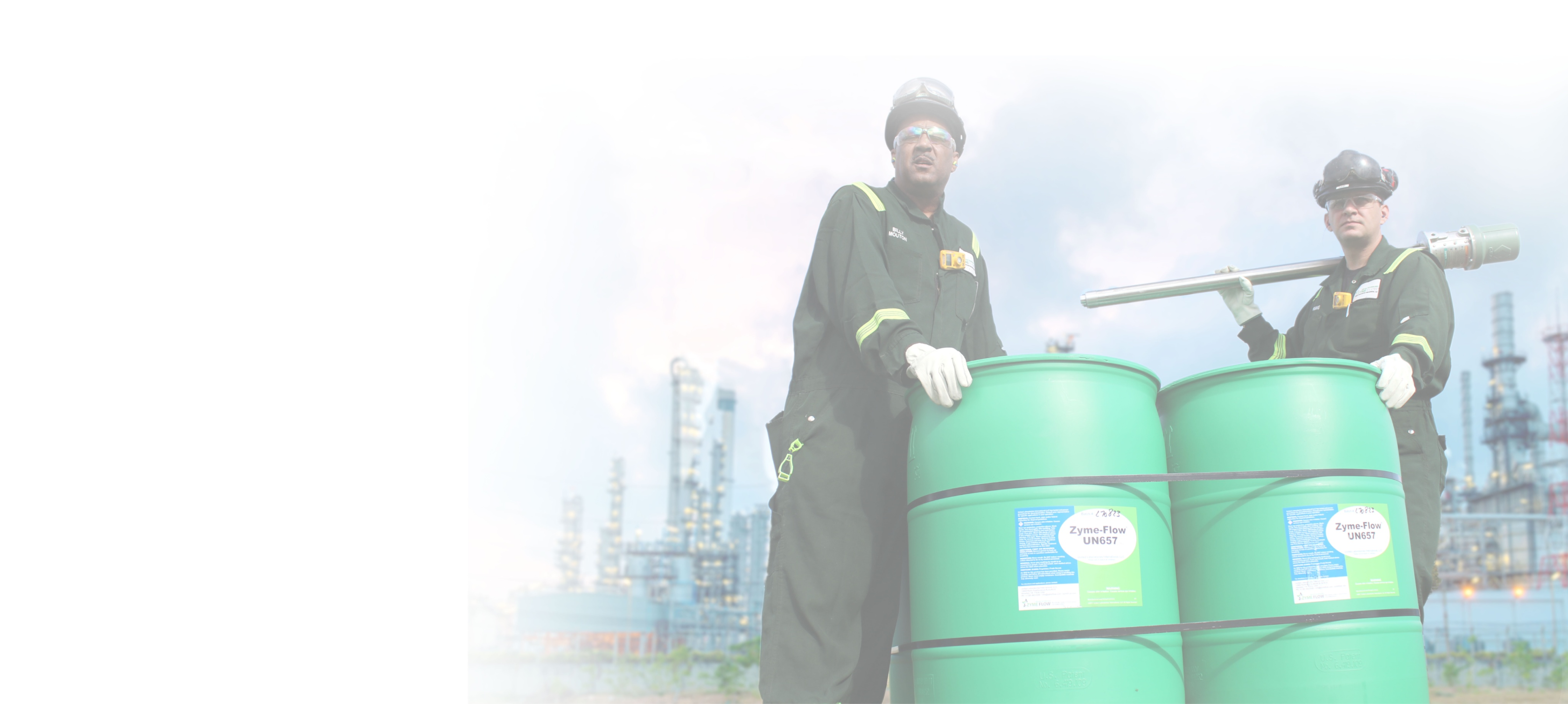Technical Tank Cleaning
Faster Cleanouts. Less Work. Lower Risk.
TankZyme drops into standard workflows to shrink the critical path without adding laydown or hardware. Use closed-tank, non-entry methods to limit LEL/VOC exposure, dose cutter stocks to melt asphaltics and polymers, or inject oxidizers to neutralize sulfides and free trapped VOCs in a single pass.
- Non-entry options: Closed-tank processing slashes LEL/VOC exposure
- Direct H₂S elimination: Mild oxidizer injects straight into the vessel
- High-potency dissolution: Add 1–3% to cutter stock to liquefy heavy ends
Meet the Family
Purpose-built chemistries for heavy crude tanks, sour-water service, storage tanks, and stubborn asphaltenes.
TankZyme 3PS: Non-Entry Three-Phase Separation
Non-entry cleaning for paraffinic and heavy-crude tanks. Circulate to split hydrocarbons, water, and inorganics into three distinct layers; pump off oil that meets BS&W specs, send water to wastewater, and leave only water-wet solids for a light final clean.
- Demulsifier + paraffin fluidizer: recovered oil meets BS&W.
- Less effluent and handling gear than manual methods.
- Easier solids removal: only water-wet fines remain.
TankZyme H2S: Sour-Water Eliminator
A safer, one-step treatment for H₂S and pyrophorics in sour-water tanks. Mild oxidizer injects directly (no mix tank), then permanently eliminates H₂S (non-reversible) to prevent regeneration. Non-toxic, no exotherms, and 100% biodegradable for simpler disposal.
- Replace batch treatments; tailor dose to content and constraints
- Compatible with common metals and seals; no VOCs
- Non-hazardous precipitate helps lower disposal cost
TankZyme SC: Storage-Tank Oxidizing Cleaner
One-step oxidation and de-oiling for storage and product tanks. Oxidizes sulfides/pyrophorics, de-oils solids, and promotes rapid VOC liberation via steam or water injection without the hazardous residues common to permanganates or other high-risk oxidants.
- 100% biodegradable, non-exothermic, high flash point
- Recovered oil is reprocessable; clean-breaking separation
- Begins during de-inventory; minimal agitation required
TankZyme HP: High-Potency Solvent Additive
Turn your cutter stock into a heavy-end solver. Dose 1–3% into LCO, diesel, naphtha, kerosene, light sweet crude, or HVGO (temperature limited by carrier flash point, ~up to 400 °F) to dissolve asphaltics and polymeric deposits. Expect cleaner surfaces with less hydroblasting and fewer hours inside.
- Cuts total cutter-stock volume and disposal.
- Compatible with common tank metals and gaskets.
- Asphaltenic recoveries can route to slop oil.
Have Questions? We Have Answers.
TankZyme is a family of tank-cleaning chemistries built for heavy crude and product tanks where you want faster cleanouts, fewer man-hours, and lower effluent. Programs cover non-entry three-phase separation, direct H₂S knockdown, oxidizing/de-oiling cleaners, and high-potency dissolution that turns cutter stock into a heavy-end solver. You get closed-tank options to limit LEL/VOC exposure and process-friendly handling for recovered oil and water.
TankZyme 3PS is a non-entry, closed-tank program for paraffinic/heavy-crude tanks. It separates hydrocarbons, water, and inorganics into three distinct phases so oil meets BS&W, water routes to wastewater, and only water-wet solids remain for a light final clean—cutting exposure, effluent, and handling gear versus manual methods.
Use TankZyme H2S. It’s a mild oxidizer that you inject directly into the vessel (no mix tank), eliminating high H₂S and pyrophorics in one step. The reaction is non-reversible (no H₂S regeneration), non-toxic, 100% biodegradable, no exotherms, no VOCs, and the precipitate is non-hazardous, helping lower disposal costs.
TankZyme SC is a steam- or water-injectable cleaner that oxidizes sulfides/pyrophorics, de-oils solids, and promotes rapid VOC liberation in one step. It’s 100% biodegradable, non-exothermic, high flash point, and recovered oil can be reprocessed. Unlike permanganates and other high-risk oxidants, SC avoids hazardous residues, explosion hazards, and corrosion issues—eliminating waste-disposal problems common with legacy methods.
Yes. 3PS removes oil and water first so only water-wet fines remain with less manual dig-out. HP (high-potency solvent additive) liquefies asphaltics and polymeric deposits so more washes out, minimizing hydroblasting and manned entry.
When asphaltics, tars, waxes, or polymeric residues are the bottleneck. TankZyme HP doses 1–3% into LCO, diesel, naphtha, kerosene, light sweet crude, or HVGO to amplify dissolution. It tolerates up to ~400 °F (limited by carrier flash point), reduces total cutter-stock volume, and supports feedstock reclamation with less waste generated.
TankZyme 3PS: Non-entry, three-phase separation for paraffinic/heavy-crude tanks; oil to spec, water to WW, minimal solids left.
TankZyme H2S: Sour-water/H₂S tanks; direct injection, non-reversible H₂S elimination, biodegradable, no exotherms, no VOCs.
TankZyme SC: Storage/product tanks needing one-step oxidize + de-oil + VOC liberation via steam/water; reprocessable oil, no hazardous residues.
TankZyme HP: High-potency dissolution via 1–3% in cutter stock; fewer entry hours, less hydroblasting, lower waste.

Get Your Tank Back in Service Sooner
Share your tank type, contents, and constraints and we’ll recommend a TankZyme chemistry that reduces risk, man-hours, and days off line.
